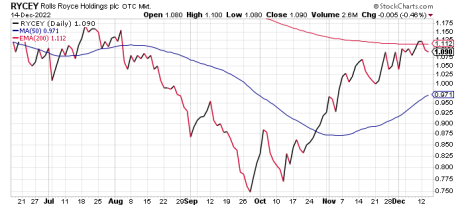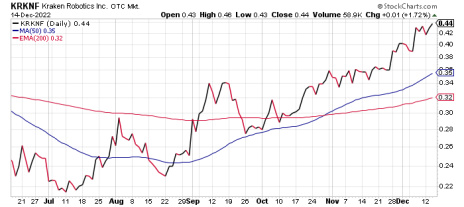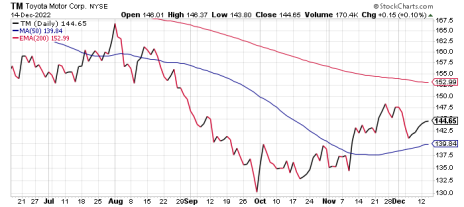Weekly Stock Roundup
Portfolio Changes:
Move Marvell (MRVL) to a Sell
The Fed raised benchmark interest rates a half a point and signaled more to come. Elsewhere, scientists studying fusion energy at Lawrence Livermore National Laboratory have crossed a huge milestone in reproducing the power of the sun in a laboratory. Explorer positions showed relative strength, led again by Kraken (KRKNF). Today we go to Britain for a historic and strategically important company, brand, and stock selling for a bit over $1 a share.
Centrus Energy (LEU) shares were steady this week on no news. This is still a buy for aggressive investors as interest in expanding nuclear power gains momentum.
Corteva (CTVA) shares fell from 64 to 62 following a recent agreement to buy biologicals firm Stoller Group, with operations in 60 countries, for $1.2 billion. Biologicals use materials that already exist in nature to replace synthetic ingredients in chemical pesticides since pest and crop diseases are growing more resistant to synthetic chemicals. Corteva expects the biologicals market to represent about 25% of the overall crop protection market by 2035.
Ford (F) shares inched up this past week as the company is ramping up efforts to boost the production of the F-150 Lightning, adding a third production shift in the Michigan plant assembling this model.
Infineon Technologies (IFNNY) shares were up a point as this semiconductor solution supplier company was ranked Europe’s eighth-largest tech company by revenue.
Kraken Robotics (KRKNF) shares were up more than 4% yesterday as Investor’s Business Daily highlighted the stock as its top robotics stock, which is surprising given its size. The article cited Kraken’s acquisition of PanGeo and its role pioneering Robotics-as-a-Service (RaaS), which involves companies paying a recurring fee for access to the company’s various underwater robotics products, services, and data.
Marvell Technology Group (MRVL) shares were up three points this past week but since the company is currently trading around 18 times estimated forward earnings and earnings estimates are falling, I’m moving this stock to a sell.
MP Materials (MP) shares were unchanged this week as the company moves ahead with developing its rare earths processing technology and its Mountain Pass mine, which supplies around 15% of the world’s production of rare earths, a group of 17 minerals used to make the magnets in America’s most advanced commercial and military technology, from electric vehicles to Virginia-class attack submarines.
Novo Nordisk (NVO) shares gained a little ground this week. Through the first nine months of 2022, Wegovy’s sales have totaled 3.7 billion Danish Krone ($524 million), which is more than six times what it generated a year ago. However, CEO Lars Fruergaard Jørgensen admits the company underestimated demand and Novo has since increased capacity, which should enable it to fulfill all its orders in 2023.
Toyota Motors (TM) shares gained a couple of points as the market awaits its new, more powerful and sportier Prius 2023 to hit the market. The new Prius will join eight other hybrid models, plus the all-new Toyota Crown, and two plug-in hybrid models.
Market Brief
First up is the big news that could put climate change in the rear window and make some investors a lot of money. Scientists studying fusion energy at Lawrence Livermore National Laboratory have crossed a huge milestone in reproducing the power of the sun in a laboratory. They have for decades talked about how fusion, the nuclear reaction that makes stars shine, could provide a future source of bountiful energy. This is the first fusion reaction in a laboratory setting that produced more energy than it took to start the reaction.
Second, emerging markets (EM) seem to be undervalued and deserve some consideration despite the choppy market. Look at the below chart showing the lowest EM valuations in a decade.
What could ignite emerging markets? The belief that we are at a peak in the strength of the U.S. dollar, for one. As the dollar potentially weakens, EM countries could benefit from the relative appreciation of their own currency. Additionally, commodity exporters, such as countries in Latin America, could see commodity prices strengthen due to greater global demand. With the U.S.-China rivalry, the reorganization of strategic supply chains could create new opportunities for EM nations other than China. In areas such as consumer and industrial goods, I anticipate new relationships between the U.S. and India, Latin America and countries in Southeast Asia, as well as opportunities in South Korea, Taiwan and Brazil.
New Recommendation: Rolls-Royce PLC (RYCEY)
A Strategically Important Aerospace/Defense Opportunity
When Americans think of the beginnings of the auto industry, they think of the founding of Ford in 1903 and the Model T.
But across the pond, another initiative began from the electrical and mechanical business founded by Henry Royce, followed by a chance meeting with Charles Rolls. Born was a company with a radically different strategy than Ford, founded by opposites in 1906. One was a newsboy turned railroad worker turned engineer, Royce. The other was an Eton-educated, race-car-driving aristocrat, Rolls.
This enterprise started with just 60,000 pounds of capital and produced only 200 autos a year.
The “Silver Ghost” was a beauty. The epitome of elegance, quality, and superior engineering, durability, and performance. Almost all were driven by chauffeurs: “Your Lordship’s car is waiting.”
The Rolls-Royce mystique was built by engineering, custom craftmanship and a very high price tag.
Soon, the company branched out into aero engines for WWI. The “Eagle” became a mainstay of the British war effort as the company produced 50 engines a week by the end of the war “to end all wars.”
In World War II, Rolls-Royce went into overdrive, churning out 80,000 aero engines such as the “Merlin” powered fighter that pushed back the Germans in the Battle of Britain.
The Merlin powered the British Spitfire, the Hawker Hurricane, and the P-51 Mustang as the speed and range steadily advanced due to constant and incremental innovation, which the Japanese refer to as “kaizen”.
Rolls-Royce also worked with Ford and Packard to maximize production and then Boeing, BMW and Lockheed as the world hurtled into the jet age. Unfortunately, a poor economy and mismanagement resulted in a government takeover in 1971 and the prized auto business was spun off to BMW in 2003 and eventually acquired by Vickers. During the Thatcher revolution, Rolls-Royce was privatized and back on track.
Now Rolls-Royce operates as an industrial technology company in the United Kingdom and internationally. The company operates in four segments: Civil Aerospace, Power Systems, Defense, and New Markets. The Civil Aerospace segment develops, manufactures, and sells aero engines for large commercial aircraft, regional jet, and business aviation markets, as well as provides aftermarket services. The Power Systems segment engages in the development, manufacturing, marketing, and sale of integrated solutions for onsite power and propulsion for the marine, defense, power generation, and industrial markets.
The Defense segment offers aero engines for military transport, naval engines and submarine nuclear power plants. Finally, its New Markets segment develops and manufactures small modular reactors.
Hydrogen-Fueled Jets and Modular Nuclear Energy
The aviation industry’s use of conventional jet fuel has angered climate change activists.
Just last week, Rolls-Royce announced the successful test of an aircraft engine that runs on hydrogen. The British company built the engine using a converted Rolls-Royce AE 2100-A with the British airline easyJet to explore replacing carbon-intensive fuels used in aviation. With a second round of engine tests planned, Rolls-Royce said it hopes to eventually carry out full flight tests using hydrogen-powered engines.
Comprised of 6,000 cells and an advanced cooling system that can withstand extreme temperatures, the plane’s battery is a feat of engineering.
Next up for Rolls-Royce is modular nuclear power as the U.K. seeks to improve energy security and reduce its reliance on Russian oil.
Last month, Rolls said its small modular reactors (SMRs) could supply a fifth of the U.K.’s total electricity capacity to homes across England and Wales by the end of the decade. The reactors use existing nuclear technology on a smaller scale than traditional power plants. Each can generate about 470MW of power and last at least 60 years.
The push for approvals comes as deals are signed elsewhere. GE Hitachi Nuclear Energy signed a deal last year with Canada’s Ontario Power Generation that could be online as early as 2028. Deals for GE to build 10 more in Poland followed weeks later.
Rolls-Royce’s design aims for a price of less than a tenth of the cost of the most modern large power station while providing about 70% of the power. This is the fastest way to get new nuclear on the grid, with each SMR providing one million homes with low-carbon electricity.
Rolls-Royce stock (RYCEY) has been hard hit by the impact of Covid on air travel and thus the miles flown by Rolls-powered commercial jets, which is how it derives much of its revenue. The result is the company has taken on quite a bit of debt. However, the tide seems to be turning and downside risk is offset by how important the company is to the U.K. and U.K. government because of its strategically important aerospace and defense business.
But keep in mind that with shares trading at a bit over $1 a share, Rolls-Royce is an aggressive idea.
Incoming CEO Tufan Erginbilgic could lower expectations by flagging weaker-than-expected free cash flow and downplaying the anticipated recovery in engine flying hours.
Shares in RYCEY have slipped more than 29% over the past one-year period due to investor worries over the pace of the aviation industry’s recovery from the pandemic.
Still, I believe that longer-term investors will be rewarded since it seems to me that upside in the stock is much greater than downside and that Rolls-Royce remains well-positioned to handle potential headwinds facing the sector. BUY A HALF POSITION
Model Portfolio
| Stock | Price Bought | Date Bought | Price 12/14/22 | Profit | Rating |
| Centrus Energy (LEU) | 27 | 7/8/22 | 34 | 25% | Buy a Half |
| Corteva (CTVA) | 66 | 11/11/22 | 62 | -7% | Buy a Half |
| Ford (F) | 20 | 11/23/21 | 13 | -34% | Buy a Half |
| Infinenon Technologies (IFNNY) | 25 | 7/22/22 | 34 | 33% | Buy a Half |
| Kraken Robotics (KRKNF) | 0.28 | 9/2/22 | 0 | 57% | Buy a Half |
| Marvell Technology, Inc. (MRVL) | 41 | 10/27/22 | 43 | 4% | Sell |
| MP Materials (MP) | 35 | 8/4/22 | 31 | -11% | Hold a Half |
| Novo Nordisk (NVO) | 126 | 12/2/22 | 135 | 7% | Buy a Half |
| Rolls-Royce PLC (RYCEY) | -- | NEW | 1 | --% | Buy a Half |
| Toyota Motors (TM) | 135 | 10/14/22 | 145 | 7% | Buy a Half |
| WisdomTree Emerging Markets High Dividend Fund (DEM) | 32 | 9/29/22 | 36 | 12% | Buy a Half |
Explorer Stocks in Brief
Centrus Energy (LEU) surprised investors as it came out with a quarterly loss of -$0.42 per share versus the Zacks consensus estimate of +$0.78. This compares to earnings of $2.95 per share a year ago. This nuclear fuel supplier for utilities in the U.S. and abroad has net income margins that are above 50% so far this year with new nuclear fuel sales contracts and commitments worth an estimated value of $270 million.
Nuclear power provides 20% of the power for our electricity grid and more than 50% of U.S. emission-free energy, according to the Department of Energy. BUY A HALF
Corteva (CTVA) uses emerging technology to help farmers improve crop yields and boost output. While the market is down sharply over the past year, CTVA is up more than 33%. Although the down market does lead to quality companies growing top-line revenue and net profits trading at bargain prices, a strong case can be made for stocks like Corteva that are recession-resistant and outperforming the market on a relative basis. Recently, Corteva reported a 12% increase in net sales and beat earnings expectations by about 50%. BUY A HALF
Ford (F) is making a transition to a leader in both conventional and electric vehicles (EVs). Ford has a forward price-to-earnings ratio of just over 7 with a dividend yield of 4.4%. It continues to see rising demand for its electric vehicles and Ford stock will benefit from big $7,500 EV subsidies. Ford remains my favorite conservative stock despite a challenging market and supply chain issues. Ford wants to produce EVs at annual rates of 600,000 cars by late 2023 and more than 2 million by 2026. BUY A HALF
Infineon Technologies (IFNNY) has an advantage on many other semiconductor stocks in that it is focused on auto and industrial markets where shortages and high demand persist, allowing it to raise prices. This stock seems undervalued to me with a forward price-to-earnings ratio of 14 while the company’s earnings per share is expected to grow 10% this (fiscal 2023) year and cash flow growth is strong. This is still a buy on dips in the market. BUY A HALF
Kraken Robotics (KRKNF) is probably the most speculative of Explorer stocks, but it is a well-run company and a prime takeover candidate in the growth defense sector coupled with a strong management team. Based in Newfoundland, Kraken Robotics is a marine technology company providing ultra-high resolution, software-centric sensors and underwater robotic systems. BUY A HALF
Marvell Technology Group (MRVL) designs, develops and sells a wide variety of semiconductor products that are at the core of 5G-capable networks, processors and devices as they partner with and transition to 5G. The company’s embedded processors and products are cutting-edge and already generate $3 billion in annual sales. Since the company is currently trading around 18 times estimated forward earnings and these estimates are falling, I’m moving this stock to a sell. MOVE FROM BUY A HALF TO SELL
MP Materials (MP) is an effective way to play clean tech, defense, semiconductors, and other advanced and emerging technologies. Based on its valuation, MP is moving closer to being rated a buy and is America’s only active rare earth mining and processing site, producing approximately 15% of the rare earth content consumed in the global market in 2021. HOLD A HALF
Novo Nordisk (NVO) specializes in treatments for diabetes, hemophilia, and obesity. The company supplies half of the world’s insulin, and its diabetes care products are used by over 34 million people today. Novo highlights that more than 750 million are currently living with obesity, a figure that is up by a multiple of 3X since 1975. By 2025, it’s estimated the potential market for obesity-related ailments will equal 1.2 trillion.
Novo’s total sales already exceed $167 billion a year and for the quarter ending in September, earnings were up 19% on a 28% increase in revenue. Novo is also executing a $3 billion share repurchase plan. In summary, based on its sizable and growing demand for its weight-loss drug, this well-managed, highly profitable company with an excellent growth profile and potential to develop new products has limited risk. Its stock is outperforming the market, indicating relative strength. BUY A HALF
Toyota Motors’ (TM) hybrid EV sales jumped 73% last year according to research firm Motor Intelligence. Toyota pioneered hybrid cars in the late 1990s with the Prius, and hybrids, including plug-in cars, accounted for around 20% of Toyota’s U.S. sales in September. Toyota remains the No. 1 hybrid seller in America, led by a gas-electric version of the RAV4 sport-utility vehicle, the nation’s top-selling hybrid. Toyota projects that about half of its spending from 2022 through 2030 will be focused on electric vehicles, including a new $3.8 billion battery plant in North Carolina opening in 2025. BUY A HALF
Explorer ETF/Fund Positions
WisdomTree Emerging Markets High Dividend Fund (DEM) offers a high dividend yield and some of the highest quality emerging market stocks in the world with an average price-to-earnings ratio of around 5. This ETF gives broad exposure with an emphasis on income and value. BUY A HALF
The next Cabot Explorer issue will be published on December 29, 2022.
JUST PUBLISHED — New book from Chief Analyst Carl Delfeld












